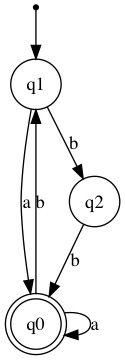Learning Deterministic Finite Automata (DFA) from Examples Using SAT
Implements the reduction to SAT for learning (synthesizing) a DFA that accepts a given set of strings, and rejects another given set described in [Heule & Verwer, 2010]. The input for the reduction is a file with the two set of strings and an integer N. The output is a CNF theory that is satisfiable iff there is a DFA with N states that is compatible with the input file. In the positive case, the DFA can be obtained from a model for the theory.
Go to the src/ folder and execute 'make'.
The file begins with a line containing two integers n and m where n is the number of symbols in the alphabet, and m is the number of samples (strings) in the file. Then, a line containing the integer n followed by n blank-separated strings specify the symbols in the input alphabet. (The symbols are not necessarily of lenght equal to 1.)
For example, the file preamble
2 6
2 a b
tells that the file contains a sample of 6 strings made from
an alphabet of two 'symbols' which are a and b.
The last part of the file contains the positive and negative samples. First, a single line containing number p less than or equal to m tells that there are p positive samples (i.e. strings that should be accepted by the DFA). After this line, there are p lines, each containing one string. Each such line begins with an integer that tells the length of the string (0 if the string is empty) followed by a blank-separated list of symbols from the alphabet that make up the string. The negative samples are specified in a similar way.
For example, the file
2 6
2 a b
3
1 a
4 a b a a
2 b b
3
3 a b b
1 b
0
describes a sample of 6 strings over the alphabet { a, b }
with 3 positive samples: a, abaa, and bb, and
3 negative samples: abb, b, and the empty string.
The executable src/dfa accepts the following options and arguments
src/dfa-sat [--decode] [--disable-redundant] [--disable-symmetries-break-using-graph-clique] [--enable-redundant-graph-edges] <prefix> <K>
where <prefix> is the prefix for all files, and K is number of
colors (states in the DFA). The option --decode is used to decode
a model found by minisat. If it is specified, the model is assumed to
be in the file <prefix>_<K>_model.cnf. The resulting DFA is
generated in .dot format in the file <prefix>_<K>_dfa.dot. A PDF
representation of the DFA can be obtained using dot:
dot -Tpdf <prefix>_<K>_dfa.dot > <prefix>_<K>_dfa.pdf
If the option --disable-redundant is enabled (not recommended),
then redundant clauses are not generated.
The option --disable-symmetries-break-using-graph-clique disables
the generation of clauses that break symmetries which can be specially
effective when there is no solution for a given K. It is not
recommended to disable such clauses.
The option --enable-redundant-graph-edges is used to add clauses
associated with the edges of the induced undirected graph. The number
of such edges, and thus clauses, may be quite large. Since these are
redundant clauses, we don't recommend the use of this option in
general. However, it could be useful in some cases.
The folder examples/ contains some examples. To run dfa-sat on 'example' from the examples/ folder, execute:
../src/dfa-sat example 3 # generates example_3_theory.cnf
minisat example_3_theory.cnf example_3_model.cnf # generates example_3_model.cnf
../src/dfa-sat --decode example 3 # generates example_3_dfa.dot
dot -Tpdf example_3_dfa.dot > example_3_dfa.pdf # generates example_3_dfa.pdf
This generates a DFA with 3 states for the strings in example_sample.dat.
The generated DFA is the following:
Clearly, this DFA accepts a, bb, and abaa, and rejects (does
not accept) <empty>, b, and abb. There is no DFA with 1 or
2 states that is compatible with this sample (i.e. with the positive and
negative strings in the sample).
- Marijn J.H. Heule and Sicco Verwer. Exact DFA Identification Using SAT Solvers. Int. Conf. Grammatical Inference (ICGI-2010). Pages 66-79. 2010.
